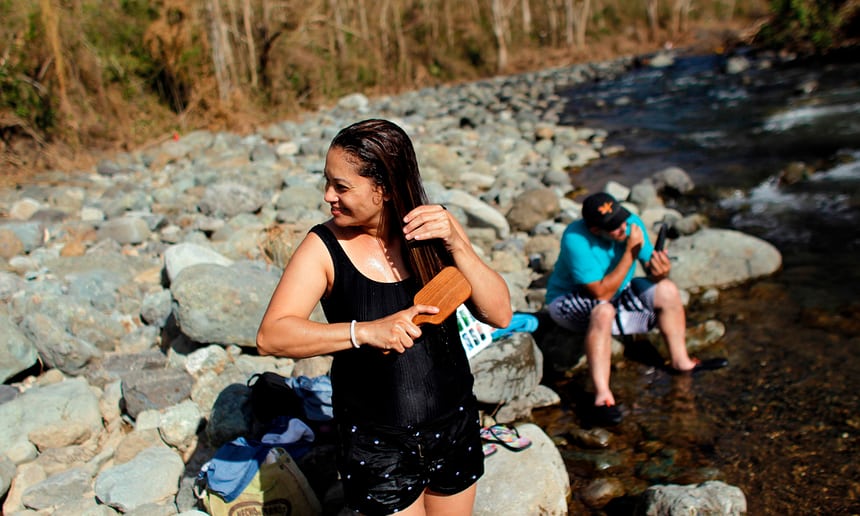SAN JUAN — Not long after Hurricane Maria tore through Puerto Rico, unleashing floodwaters, flattening homes, and knocking out the power supply, Consuelo Quezada noticed another, more subtle, change to life on the island.
Attending her first mass after the storm, Quezada saw that her fellow churchgoers did not have their usual Sunday morning hairstyles.
“I think I just saw everyone’s real hair for the first time in my life,” she told her family after the service.
Four months after the hurricane made landfall, ordinary life in this U.S. commonwealth is still far from normal: about 60,000 homes are still without roofs, 2.3 million people live in areas at risk of water contamination, and 15.5 percent of the population still lacks electricity.
The island, already billions of dollars in debt before the storm, faces a repair bill of some $94 billion. The official death toll is 64 people but news agencies estimate the true number is closer to 1,000.
Amid this devastation, the disaster has also forced smaller changes to day-to-day life – including the way Puerto Ricans style their hair.
The constant heat and high humidity – coupled with months without power and clean water – means that long, blown-straight hair no longer dominates the island.
Instead, men and women across the island favour natural curls and undyed roots. Women with long hair pull it into a ponytail or a bun, or even hide it under a cap. Men are growing their beards longer than usual and skipping haircuts.
In a darkly humorous show called After Maria, Teatro Breve – a performance art theater company in San Juan – poked fun at Puerto Rico’s new normal, including the island’s newest hairstyles. They include the “messy bun”, the “dirty braid”, and “el moja’ito” (the wet one) – in which women use an excessive amount of gel to make it seem they had just come out of the shower.
Mayda Berrios, who works at a SuperCuts in the the city of Carolina, said that since the hurricane many of her clients had asked for shorter hair.
“Women came saying, ‘I have no power, I need to cut it shorter,’” Berrios said. “Men ask for a shorter-than-usual trim so their haircut would last longer.”
The salon reopened two weeks after the hurricane, and to Berrios’s surprise, the number of walk-in clients was similar to a regular week. Her working conditions, however, were far from normal.
There was no electricity, and the salon had no generator, so for two months the salon was dimly lit and stifling hot. Blow-drying or flat-ironing were out of the question.
“Everyone left with their hair wet,” said Berrios. “At least the company gave us battery-operated clippers for men. We charged them every day in our cars or the Walmart across the parking lot.”
Even now, power has been restored to less than 64 percent of homes and businesses, according to the latest data from the US Department of Energy.
Across the island, barbers and stylists have shifted their business out of un-ventilated shops and on to the cooler sidewalks.
Haircuts have also become a form of currency. Miguel Camilo, from Guaynabo, described how a neighbor gave haircuts to his friends in exchange for a power generator.
“As soon as he got a generator, he set up a tent on his driveway, put out a chair, and gave haircuts to anyone who wanted it,” said Camilo.
Towns and villages in the poorer interior of the island have had to wait much longer to have electricity, phone coverage and other normal services restored.
Alexander Carrasquillo, a pharmaceutical industry supervisor from Yabucoa, took action by creating De Corazón a Corazón (From Heart to Heart), a family and friends’ movement with more than 30 volunteers aimed at bringing aid to hard-struck municipalities such as Utuado, Arroyo, Lares, and Las Piedras.
Along with providing basic necessities, the group also brought medical and legal services – and hairstyling.
“It was special because you could see their faces after they got their haircuts,” said Carrasquillo. “You could see how their self-esteem increased and gave them a more resilient attitude towards their current status. It lifted their spirit.”
Before the aid brigade visited a town, community leaders took the names of every person who wanted a haircut; in some towns the waiting list had as many as 80 or 90 people.
“We offered basic haircut services to people who really needed it because we wanted to help the community. We didn’t do any hair dying or extra services because we didn’t want to take any business away from local salons. Besides, we were working in basketball courts and using one portable power generator that could barely power our trimmers,” said Rivera Manzano.
After the group received a donation from a church in Florida, Carrasquillo also gave (of $10 or $20) to each person who received a haircut. But not everyone took the payment.
“Some of them were too humble,” Carrasquillo said. “They didn’t want to accept the money. They were happy with just a haircut.”





